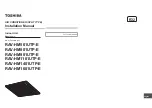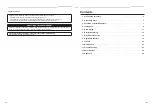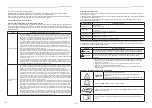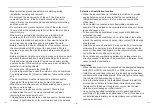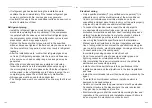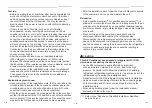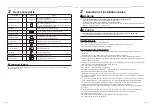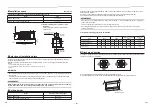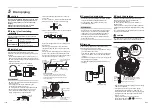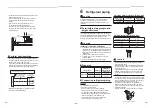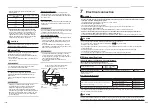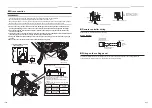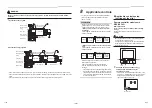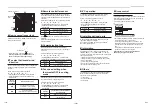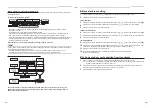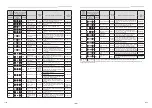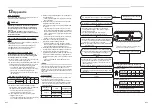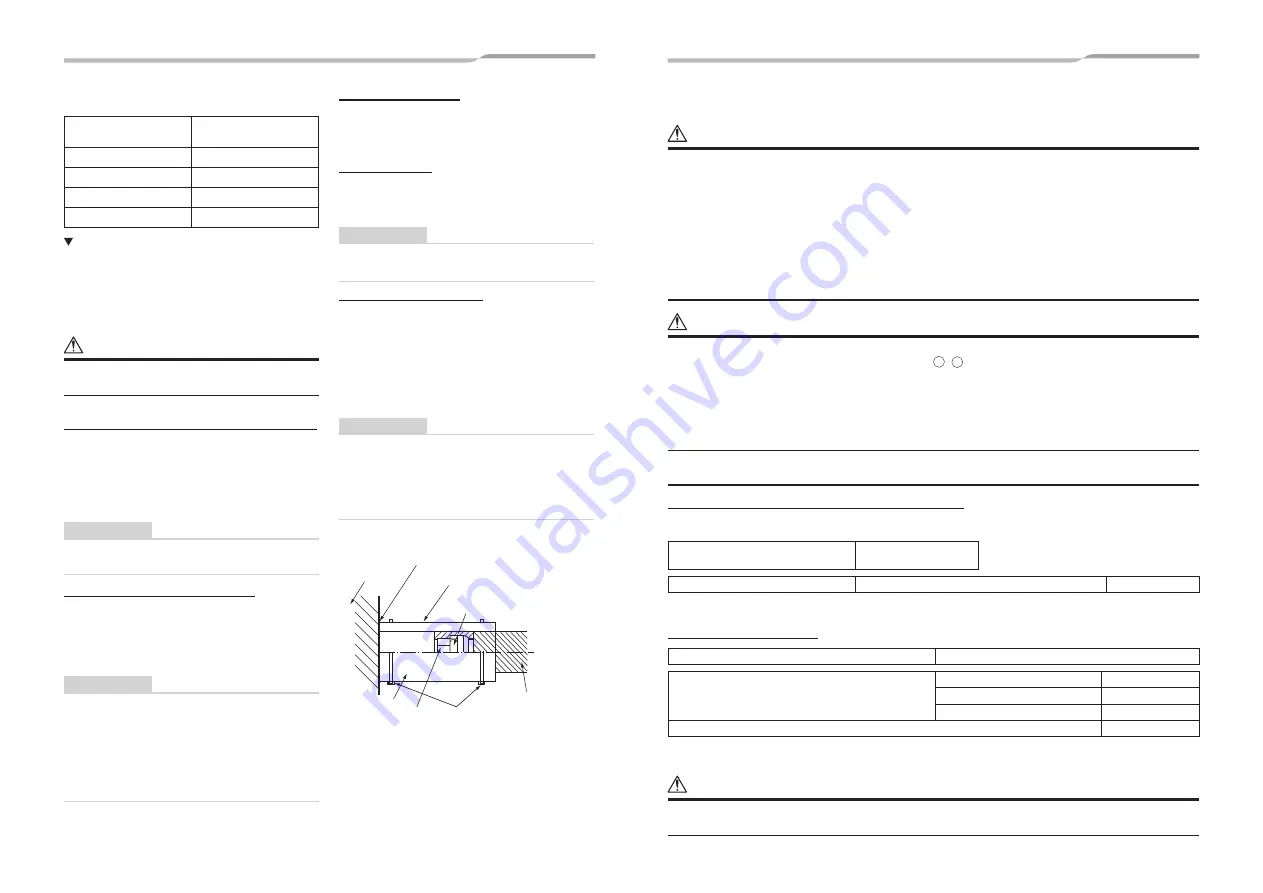
26-EN
25-EN
– 13 –
•
Use the tightening torque levels as listed in the
following table.
Outer dia. of connecting
pipe (mm)
Tightening torque (N
•
m)
6.4
14 to 18 (1.4 to 1.8 kgf
•
m)
9.5
34 to 42 (3.4 to 4.2 kgf
•
m)
12.7
49 to 61 (4.9 to 6.1 kgf
•
m)
15.9
63 to 77 (6.3 to 7.7 kgf
•
m)
Tightening torque of
fl
are pipe connections
Incorrect connections may cause not only a gas
leak, but also a trouble of the refrigeration cycle.
Align the centres of the connecting pipes and
tighten the
fl
are nut as far as possible with your
fi
ngers. Then tighten the nut with a spanner and
torque wrench as shown in the
fi
gure.
CAUTION
Tightening with an excessive torque may crack the nut
depending on installation conditions.
Evacuation
Perform vacuuming from the charge port of valve of
the outdoor unit by using a vacuum pump.
For details, follow to the Installation Manual attached
to the outdoor unit.
•
Do not use the refrigerant sealed in the outdoor unit
for evacuation.
REQUIREMENT
For the tools such as charge hose, use those
manufactured exclusively for R32.
Refrigerant amount to be added
For addition of the refrigerant, add refrigerant “R32”
referring to the attached Installation Manual of
outdoor unit.
Use a scale to charge the refrigerant of speci
fi
ed
amount.
REQUIREMENT
•
Charging an excessive or too little amount of
refrigerant causes a trouble of the compressor.
Charge the refrigerant of speci
fi
ed amount.
•
A personnel who charged the refrigerant should
write down the pipe length and the added refrigerant
amount in the F-GAS label of the outdoor unit. It is
necessary to
fi
x the compressor and refrigeration
cycle malfunction.
Open the valve fully
Open the valve of the outdoor unit fully. A 4 mm-
hexagonal wrench is required for opening the valve.
For details, refer to the Installation Manual attached to
the outdoor unit.
Gas leak check
Check with a leak detector or soap water whether gas
leaks or not, from the pipe connecting section or cap
of the valve.
REQUIREMENT
Use a leak detector manufactured exclusively for HFC
refrigerant (R32, R134a, R410A, etc).
Heat insulation process
Apply heat insulation for the pipes separately at liquid
side and gas side.
•
For the heat insulation to the pipes at gas side, use
the material with heat-resisting temperature 120 °C
or higher.
•
To use the attached heat insulation pipe, apply the
heat insulation to the pipe connecting section of the
indoor unit securely without gap.
REQUIREMENT
•
Apply the heat insulation to the pipe connecting
section of the indoor unit securely up to the root
without exposure of the pipe. (The pipe exposed to
the outside causes water leak.)
•
Wrap heat insulator with its slits facing up
(ceiling side).
Wrap the pipe with the attached heat insulator
without any gap between the indoor unit.
The seam must be faced upward
(ceiling side).
Flare nut
Indoor unit
Heat insulation
pipe
(Accessory)
Banding band
(locally
procured)
Heat insulator
of the pipe
Union
7
Electrical connection
WARNING
•
Use the speci
fi
ed wires for wiring connect the terminals. Securely
fi
x them to prevent external forces applied
to the terminals from affecting the terminals.
Incomplete connection or
fi
xation may cause a
fi
re or other trouble.
•
Connect earth wire. (grounding work)
Incomplete grounding cause an electric shock.
Do not connect earth wires to gas pipes, water pipes, lightning conductor or telephone earth wires.
•
Connect earth wire. (grounding work)
Capacity shortage of power circuit or incomplete installation may cause an electric shock or a
fi
re.
•
Under no circumstances, the power supply wire or the indoor and outdoor connecting wire must not be
connected in the middle (Connection using a solderless terminal etc.)
Connection trouble in the places where the wire is connected in the middle may give rise to smoking and/or a
fi
re.
CAUTION
•
For power supply speci
fi
cations, follow the Installation Manual of outdoor unit.
•
Do not connect 220 – 240V power to the terminal blocks (
A
,
B
) for control wiring.
Otherwise, the system will fail.
•
Do not damage or scratch the conductive core and inner insulator of power and Indoor / Outdoor connecting wires
during peeling them.
•
Perform the electric wiring so that it does not come to contact with the high-temperature part of the pipe.
The coating may melt resulting in an accident.
•
Do not turn on the power of the indoor unit until vacuuming of the refrigerant pipes completes.
Wiring speci
fi
cations
Indoor / Outdoor connecting wires speci
fi
cations
Indoor unit power supplied from outdoor unit
y
The outdoor unit power supply patterns vary on models.
Indoor unit power supply
1~50 Hz 220 - 240V
1~60 Hz 220V
Indoor / Outdoor connecting wires*
4
×
1.5 mm² or more (H07RN-F or 60245 IEC 66)*
Up to 70 m
*Number of wire
×
wire size
*Including earth line
Remote controller wiring
Remote controller wiring, remote controller inter-unit wiring
Wire size: 2 × 0.5 to 2.0 mm²
Total wire length of remote controller wiring and remote
controller inter-unit wiring = L + L1 + L2 + … Ln
In case of wired type only
Up to 500 m
2 remote controllers
Up to 300 m
In case of wireless type included
Up to 400 m
Total wire length of remote controller inter-unit wiring = L1 + L2 + … Ln
Up to 200 m
* The remote controller wiring length differs depending on the remote controller used. For details, refer to the Installation
Manual attached to the remote controller.
CAUTION
The remote controller wire and Indoor / Outdoor connecting wires cannot be parallel to contact each other and cannot
be stored in the same conduits. If doing so, a trouble may be caused on the control system due to noise or other factor.

